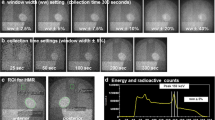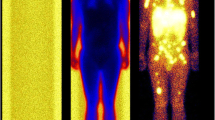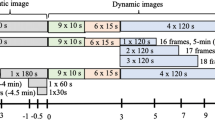Abstract
Purpose
No data are yet available in the literature concerning 3-D [123I]-meta-iodobenzylguanidine ([123I]-MIBG) kinetics in vivo. In this study we investigated the feasibility of dynamic 3-D [123I]-MIBG kinetic analysis using a CZT ultrafast camera.
Methods
The study group comprised 16 patients consecutively scheduled for [123I]-MIBG cardiac scintigraphy for clinical purpose who were studied using a CZT camera (NM530c, GE). Dynamic acquisition in list mode was simultaneously started with a bolus injection of the radiotracer (185–370 MBq) for an overall duration of 900 s. A temporal series of 3-D volumes was reconstructed from the first 150 s of dynamic acquisition with a temporal resolution of 5 s. A summed cardiac image was also reconstructed to serve as reference for blood pool (BP) and left ventricle (LV) wall identification. BP and LV volumes of interest (VOIs) were manually drawn to cover the whole heart and automatically reported on the reframed volumes. Time–activity curves (TACs) for the BP and LV were extracted by averaging the signal intensity in the respective VOI in each time frame. BP TACs were fitted to a gamma variate model while LV TACs were fitted to a bicompartmental model.
Results
TAC analysis was feasible in all patients with good interobserver reproducibility. BP TACs were well described by a gamma variate model as they represent the first pass of the tracer. The first compartment of LV TACs corresponded to contamination spillover of the LV signal from the BP signal. The LV second compartment characterized the uptake of the tracer in the myocardium quantified in terms of maximum signal intensity value (6.95 ± 2.76 counts/mm3/s2), maximum up-slope value (0.36 ± 0.15 counts/mm3/s) and normalized washout of the signal value (7.0 ± 0.6 %).
Conclusion
Using CZT technology and dynamic 3-D acquisition, analysis of [123I]-MIBG radiotracer kinetics in vivo is feasible and may provide pathophysiological information in addition to that available with standard planar and SPECT imaging.




Similar content being viewed by others
References
Chirumamilla A, Travin MI. Cardiac applications of 123I-mIBG imaging. Semin Nucl Med. 2011;41:374–87.
Jacobson AF, Senior R, Cerqueira MD, Wong ND, Thomas GS, Lopez VA, et al. Myocardial iodine-123 meta-iodobenzylguanidine imaging and cardiac events in heart failure. Results of the prospective ADMIRE-HF (AdreView Myocardial Imaging for Risk Evaluation in Heart Failure) study. J Am Coll Cardiol. 2010;55:2212–21.
Flotats A, Carrió I, Agostini D, Le Guludec D, Marcassa C, Schäfers M, et al. Proposal for standardization of 123I-metaiodobenzylguanidine (MIBG) cardiac sympathetic imaging by the EANM Cardiovascular Committee and the European Council of Nuclear Cardiology. Eur J Nucl Med Mol Imaging. 2010;37:1802–12.
Garcia EV, Faber TL, Esteves FP. Cardiac dedicated ultrafast SPECT cameras: new designs and clinical implications. J Nucl Med. 2011;52:210–7.
Positano V, Pepe A, Santarelli MF, Scattini B, De Marchi D, Ramazzotti A, et al. Standardized T2* map of normal human heart in vivo to correct T2* segmental artefacts. NMR Biomed. 2007;20:578–90.
Marquardt DW. An algorithm for least-squares estimation of nonlinear parameters. Siam J Appl Math. 1963;11:431.
Blomley MJ, Dawson P. Bolus dynamics: theoretical and experimental aspects. Br J Radiol. 1997;70:351–9.
Michaely HJ, Schoenberg SO, Oesingmann N, Ittrich C, Buhlig C, Friedrich D, et al. Renal artery stenosis: functional assessment with dynamic MR perfusion measurements – feasibility study. Radiology. 2006;238:586–96.
Thompson HK, Starmer CF, Whalen RE, Mcintosh HD. Indicator transit time considered as a gamma variate. Circ Res. 1964;14:502–15.
Tofts PS. Modeling tracer kinetics in dynamic Gd-DTPA MR imaging. J Magn Reson Imaging. 1997;7:91–101.
Davenport R. The derivation of the gamma-variate relationship for tracer dilution curves. J Nucl Med. 1983;24:945–8.
Conflicts of interest
None.
Author information
Authors and Affiliations
Corresponding author
Rights and permissions
About this article
Cite this article
Tinti, E., Positano, V., Giorgetti, A. et al. Feasibility of [123I]-meta-iodobenzylguanidine dynamic 3-D kinetic analysis in vivo using a CZT ultrafast camera: preliminary results. Eur J Nucl Med Mol Imaging 41, 167–173 (2014). https://doi.org/10.1007/s00259-013-2549-x
Received:
Accepted:
Published:
Issue Date:
DOI: https://doi.org/10.1007/s00259-013-2549-x




